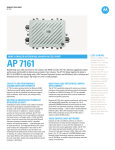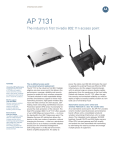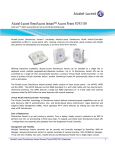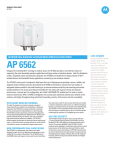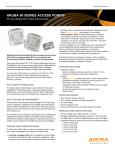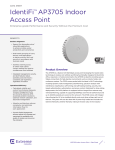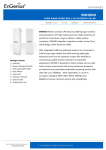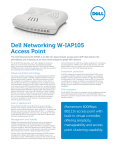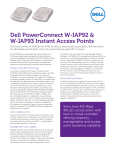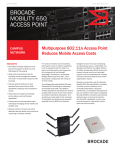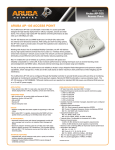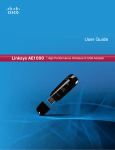Download Brocade Mobility 650
Transcript
www.brocade.com DATA SHEET BROCADE MOBILITY 650 ACCESS POINT CAMPUS NETWORK HIGHLIGHTS •Delivers optimal performance with standard Power over Ethernet (PoE) capabilities, helping to ensure always-on access •Supports a high-availability network, providing built-in reliability •Eliminates network bottlenecks with direct forwarding of traffic through Access Points (APs) •Provides secure and preemptive client roaming by leveraging device mobility and 24 dBm radio •Provides immediate help-desk support with built-in remote Radio Frequency (RF) scanning •Reduces network intrusion risk with gap-free security •Reduces complexity by enabling unified wired/wireless network management The Brocade One™ strategy helps simplify networking infrastructures through innovative technologies and solutions. The Brocade Mobility Wireless LAN (WLAN) solution supports this strategy by providing a single high-performance, highly available network that has the built-in intelligence to identify different traffic types and handle them appropriately. Multipurpose 802.11n Access Point Reduces Mobile Access Costs For small and medium-size enterprises, lowering the costs of mobility capabilities must be balanced with the need for secure and continuously reliable data transmission. The Brocade® Mobility 650 Access Point (AP), a thin (dependent) multipurpose AP, meets all of these needs. Designed to lower the cost of deploying and operating a secure, reliable 802.11n Wireless LAN (WLAN), this highly efficient AP offers simultaneous WLAN access and sensing, remote over-the-air help-desk support, and the comprehensive, wireless intrusion-prevention features that nimble organizations require. Working in conjunction with the Brocade Mobility 650 AP, Brocade Mobility controllers minimize common problems— such as building attenuation, electronic interference, or suboptimal AP placement— that can interfere with network availability. Brocade Mobility controllers automatically optimize power and channel selection with SmartRF capabilities, so each user receives always-on, high-quality mobile data and service access. ALWAYS-ON, HIGH-QUALITY ACCESS IS AUTOMATIC The Brocade Mobility 650 AP is designed to continuously optimize network availability through its central and preemptive intelligence, which dynamically senses weak or failing signals, securely moves mobile users to alternate APs, and boosts signal power to automatically fill Radio Frequency (RF) holes and ensure uninterrupted mobile user access. Full 802.11n performance is achieved with built-in Power over Ethernet (PoE) capabilities (802.3af). VIRTUAL LAN BOOSTS DEVICE AND NETWORK PERFORMANCE The Brocade Mobility 650 provides a VLAN feature through a switch/controller to accelerate device and network performance. Each Brocade Mobility 650 can be virtualized into four unique VLANs, which can be customized to direct broadcast traffic to the intended recipient. This option reduces the overall amount of network traffic while improving device performance and battery life up to 25 percent. This VLAN flexibility also reduces the overall number of APs required to provide unique device services. The Brocade Mobility 650 also supports Voice over Wireless LAN (VoWLAN) services, such as Quality of Service (QoS), which ensures toll-quality audio—even with multiple VoWLAN calls. In addition, locationing services over 802.11n provide the ability to locate and track people or assets, or control network and application access with features that provide hotspot and guest access authorization. The Brocade Mobility 650 forwards traffic directly, eliminating controller bottlenecks for improved 802.11n performance. DEVICE MOBILITY INCLUDES SECURE ROAMING AND 24 DBM RADIO The Brocade Mobility 650 supports fast, secure roaming in Layer 2 and Layer 3 deployments. In addition, the network optimizes mobile performance with load balancing, preemptive roaming, and rate scaling. The Brocade Mobility 650 features a powerful 24 dBm radio that increases coverage, performance, and obstruction penetration far more effectively than 23 dBm radios do. COMPREHENSIVE SECURITY REDUCES RISKS The comprehensive Brocade Mobility 650 security capabilities include a Layer 2–7 stateful packet filtering firewall; Authentication, Authorization, and Accounting (AAA); Remote Authentication Dial In User Service (RADIUS), wireless Intrusion Prevention System (IPS) “lite;” Virtual Private Network (VPN) gateway; and location-based access control. The AP’s sensor supports simultaneous multiband sensing (band unlocked) for both 2.4 GHz and 5.0 GHz spectrums. Rogue detection is always on with no time slicing. For advanced security, users can also add Role-Based Access Control (RBAC) and the Motorola AirDefense® wireless IPS for Brocade Mobility. DYNAMIC HELP-DESK SUPPORT IMPROVES PERFORMANCE The Brocade Mobility 650 multipurpose architecture enables IT organizations to extend immediate help-desk support on the fly—as if the technician were sitting directly under the AP. AirDefense for Brocade Mobility help-desk capabilities supported by the Brocade Mobility 650 include: •Advanced troubleshooting: Enables helpdesk technicians to immediately emulate and test user connectivity over the air from a device all the way to the back-end application and isolate the obstruction, even if it is not caused by the WLAN. •Spectrum analysis: Enables help-desk technicians to analyze the local spectrum for interference. •Vulnerability analysis: Enables helpdesk technicians to remotely scan for security breaches on the wired or wireless network on a scheduled or periodic basis to help ensure network security and regulatory compliance. PLUG-AND-PLAY DEPLOYMENT TAKES JUST MINUTES The Brocade Mobility 650 derives its intelligence from a Brocade Mobility controller, so installation is plug-and-play for optimal service in existing and new wireless WLANs. Brocade Mobility controllers discover Brocade Mobility 650 APs on the network and automatically download all configuration parameters and firmware, greatly reducing installation, maintenance, and troubleshooting costs for Layer 2 and Layer 3 deployments. UNIFIED WIRED/WIRELESS NETWORK MANAGEMENT REDUCES COMPLEXITY Managing enterprise campus networks continues to become more complex, thanks to the growth in services that rely on wired and wireless networks. Services such as Internet, e-mail, video conferencing, real-time collaboration, and distance learning all have specific configuration and management requirements. At the same time, organizations face increasing demand to provide uninterrupted services for high-quality voice and Unified Communications (UC), wireless mobility, and multimedia applications. To reduce complexity and time spent managing these environments, the easyto-use Brocade Network Advisor discovers, manages, and deploys configurations to groups of IP devices. By using the Brocade Network Advisor Device Configuration Manager tool, organizations can configure VLANs within the network, manage wireless AP realms, group wireless LAN switches into domains for Layer 3 mobility support, or execute Command Line Interface (CLI) commands on specific devices or groups of devices. Brocade Network Advisor centralizes management of the entire family of Brocade Mobility wireless products, including Brocade Mobility 650 APs and Brocade Mobility wireless controllers. BROCADE GLOBAL SERVICES Brocade Global Services offers comprehensive Essential Support for Brocade enterprise WLAN products—including hardware and 24×7 software support, software updates, and new releases—to optimize network performance. CLOUD-OPTIMIZED NETWORK ACQUISITION Brocade helps organizations easily address their information technology requirements by offering flexible network acquisition and support alternatives to meet their financial needs. Organizations can select from purchase, lease, and Brocade Network Subscription options to align network acquisition with their unique capital requirements and risk profiles. MAXIMIZING INVESTMENTS To help optimize technology investments, Brocade and its partners offer complete solutions that include professional services, technical support, and education. For more information, contact a Brocade sales partner or visit www.brocade.com. BROCADE MOBILITY 650 AP SPECIFICATIONS Performance and supported configurations Environmental specifications Radio options Temperature Operating: 0°C to 50°C (–4°F to 122°F) Storage: –40°C to 70°C (–40°F to 158°F) Operating humidity 5% to 95% (without condensation) Altitude Operating: 2438 m (8000 ft) Storage: 4572 m (15,000 ft) Electrostatic discharge +/- 15 kV (air), +/- 8 kV (contact) Single radio 802.11a/n or 802.11b/g/n support with 2×3 MIMO or RP-SMA antenna connectors; or dual-radio 802.11a/n and 802.11b/g/n support with 2×3 MIMO or RP-SMA antenna connectors Mode operation Thin (dependent) Access Point (AP) BSSID support Four BSSIDs per radio Powered clients CAM- and PSP-powered clients supported Concurrent clients Up to 127 client associations Power specifications Operating voltage 802.3af supply, 48 VDC at 12.95 W (typical), 36 VDC to 57 VDC (range) Voice prioritization; WMM-power save with TSPEC Admission Control; WMM U-APSD; Layer 1-4 packet classification; 802.1p; 802.11e; 802.11k; DiffServ/TOS, SVP, SIP CAC Operating current 270 mA (typical) Standards-based IEEE 802.3af Rate limiting Broadcast/multicast transmit rate control, client rate limiting, per radio client limit Integrated Power over Ethernet (PoE) Radio specifications Client load balancing Neighbor APs share client load by client count or traffic load Traffic management and Quality of Service Quality of Service Wireless medium Direct-Sequence Spread Spectrum (DSSS), Orthogonal Frequency-Division Multiplexing (OFDM), and 2×3 Spatial Multiplexing (MIMO) with 2 spatial streams Network standards 802.11a, 802.11b, 802.11g, 802.11n Channelization 20 MHz and 40 MHz channels Packet aggregation A-MSDU, A-MPDU Interframe spacing Reduced MIMO power save Static and Dynamic Data rates supported 802.11a: 6, 9, 12, 18, 24, 36, 48, 54 Mbps 802.11b/g: 1, 2, 5.5, 6, 9, 11, 12, 18, 24, 36, 48, 54 Mbps 802.11n: MCS 0–15 up to 300 Mbps Operating channels 5.0 GHz: all channels from 4920 MHz to 5825 MHz 2.4 GHz: channels 1–13 (2412 to 2472 MHz); Channel 14 (2484 MHz), Japan only Actual operating frequencies depend on national regulatory limits. Operating bands Federal Communications Commission (FCC) European Union, 2.412 to 2.462 GHz; 2.412 to 2.472 GHz; 5.150 to 5.250 GHz (UNII -1); 5.150 to 5.250 GHz; 5.725 to 5.825 GHz (UNII -3); 5.150 to 5.350 GHz; 5.725 to 5.850 (ISM); 5.470 to 5.725 GHz (Country-specific) Japan, 2.412 to 2.484 GHz; 4.900 to 5.000 GHz; 5.150 to 5.250 GHz Maximum available transmit power 24 dBm Transmit power adjustment 1-dB increments Antenna configuration 2×3 MIMO (transmit on two and receive on all three antennas) Wireless security Wireless IPS/IDS Authentication Rogue detection, radio provides dedicated full-time 24×7 scanning of 2.4 GHz and 5.0 GHz bands for air monitoring, wireless IPS, onboard IDS ACLS; Pre-Shared Keys (PSK); 802.1x/EAP-Transport Layer Security (TLS); Tunneled Transport Layer Security (TTLS); Protected EAP (PEAP); local authentication database, AAA Server; support for RADIUS, LDAP, and ActiveDirectory Encryption WEP 40/128 (RC4); WPA-TKIP; WPA2-CCMP (AES); 802.11i WPA2-TKIP; Multi-Cipher support Guest access Built-in captive portal; customizable login/welcome pages; URL redirection; support for external authentication and billing systems; client-client transmission disallow Internet Protocol Security Supports Data Encryption Standard (DES), 3DES, AES-128, and (IPSec) VPN AES-256 encryption; supports site-to-site VPN capabilities Stateful firewall Stateful Layer 3 packet inspection; stateful Layer 2–7 wireless firewall; Access Control Lists (ACLs) Networking services Layer 2 and Layer 3 802.1D-1999 Ethernet bridging; 802.11-802.3 bridging; 802.1Q VLAN trunking and tagging; DHCP servicer/client, BOOTP client, Dynamic DNS (DynDNS), PPPoE, NAT, LLDP, IP Filtering, Content Filtering (files or URL extensions, HTTP, SMTP, and FTP requests) NAT, ARP/Proxy ARP Management Configuration Java-based Web user interface, human-readable config file import/export, CLI (RS-232 or Telnet), SSH, HTTP/S, MIB, programmable SNMP v1/v2c/v3 trap support 2400 MHz band Statistics LAN, wireless and associated stations (accessible via Brocade Mobility Controller Web UI) Single-antenna composite transmit power: +21 dBm Dual-antenna composite transmit power: +24 dBm 5200 MHz band Software/firmware updates File Transfer Protocol (FTP) or Trivial File Transfer Protocol (TFTP), remote auto available Single-antenna composite transmit power: +19 dBm Dual-antenna composite transmit power: +22 dBm Antenna specifications Physical characteristics (internal antenna) Dimensions 24.1 cm L × 18.916 cm W × 4.360 cm H (9.5 in. L × 7.5 in. W × 1.7 in. H) Weight 0.91 kg (2.0 lb) Housing Plastic Available mounting configurations Ceiling mount (to suspended ceiling T-bars, below tile); wall mount LED indicators Two LED indicators with multiple modes indicating 2.4 GHz/5.0 GHz activity, power, adoption, and errors Ethernet ports Auto-sensing 10/100/1000 Base-T Ethernet Lock option Kensington Physical characteristics (external antenna) Dimensions 21.64 cm L × 14.10 cm W × 3.771 cm H (8.5 in. L × 5.6 in. W × 1.5 in. H) Weight 1.1 kg (2.5 lb) Housing Metal, plenum-rated housing (UL2043) Available mounting configurations Ceiling mount (above tile); wall mount LED indicators Two LED indicators with multiple modes indicating 2.4 GHz/5.0 GHz activity, power, adoption, and errors Antenna connectors Six RP-SMA Ethernet ports Auto-sensing 10/100/1000 Base-T Ethernet Lock option Kensington Maximum radio transmit power Type Integrated 2.4 GHz and 5.2 GHz dual antenna; elements with diversity (internal antenna) Six RSMA connectors for external antennas (not included) Band 2.4 to 2.5 GHz; 4.90 to 5.85 GHz (actual operating frequencies depend on regulatory rules and certification agency) Voltage Standing Wave Ratio (VSWR) Less than 2:1 (internal antenna) Antenna-specific (external antenna) Gain 2.4 GHz: 2 dBi; 5.0 GHz: 4.8 dBi (internal antenna) Antenna-specific (external antenna) Regulatory information Safety specifications UL/cUL 60950-1, IEC/EN60950-1, UL2043 (Plenum), compliance with RoHS Directive 2002/95/EC TUV EMC specifications FCC (USA), Industry Canada, CE (Europe), EN 301 489-1, EN 301 489-17, EN60601-1-2, and TELEC (Japan) Radio approvals FCC (USA), Industry Canada, CE (Europe- EN 300.328, EN 301.893), TELEC (Japan) www.brocade.com DATA SHEET BROCADE MOBILITY 650 AP SPECIFICATIONS (CONTINUED) Receiver sensitivity Receiver sensitivity (typical) at antenna housing connector (metal housing), 2400 MHz band (typical) at antenna housing connector (metal housing), 5200 MHz band Rate/MCS Mode Average sens (dBm) Rate/MCS Mode Average sens (dBm) 1 2 5.5 11 6 9 12 18 24 36 48 54 MCS0 MCS1 MCS2 MCS3 MCS4 MCS5 MCS6 MCS7 MCS8 MCS9 MCS10 MCS11 MCS12 MCS13 MCS14 MCS15 MCS0 MCS1 MCS2 MCS3 MCS4 MCS5 MCS6 MCS7 MCS8 MCS9 MCS10 MCS11 MCS12 MCS13 MCS14 MCS15 Legacy Legacy Legacy Legacy Legacy Legacy Legacy Legacy Legacy Legacy Legacy Legacy HT20 HT20 HT20 HT20 HT20 HT20 HT20 HT20 HT20 HT20 HT20 HT20 HT20 HT20 HT20 HT20 HT40 HT40 HT40 HT40 HT40 HT40 HT40 HT40 HT40 HT40 HT40 HT40 HT40 HT40 HT40 HT40 -95 -94 -93 -90 -94 -94 -94 -94 -90 -87 -83 -82 -94 -93 -91 -87 -84 -80 -79 -77 -94 -91 -88 -85 -82 -78 -77 -75 -88 -88 -87 -84 -82 -77 -76 -74 -88 -87 -85 -82 -79 -75 -73 -71 6 9 12 18 24 36 48 54 MCS0 MCS1 MCS2 MCS3 MCS4 MCS5 MCS6 MCS7 MCS8 MCS9 MCS10 MCS11 MCS12 MCS13 MCS14 MCS15 MCS0 MCS1 MCS2 MCS3 MCS4 MCS5 MCS6 MCS7 MCS8 MCS9 MCS10 MCS11 MCS12 MCS13 MCS14 MCS15 Legacy Legacy Legacy Legacy Legacy Legacy Legacy Legacy HT20 HT20 HT20 HT20 HT20 HT20 HT20 HT20 HT20 HT20 HT20 HT20 HT20 HT20 HT20 HT20 HT40 HT40 HT40 HT40 HT40 HT40 HT40 HT40 HT40 HT40 HT40 HT40 HT40 HT40 HT40 HT40 -93 -93 -93 -92 -89 -86 -82 -81 -93 -92 -90 -86 -83 -79 -78 -76 -93 -90 -87 -84 -81 -77 -75 -74 -90 -88 -86 -83 -80 -76 -74 -73 -89 -86 -84 -81 -78 -74 -72 -71 Corporate Headquarters San Jose, CA USA T: +1-408-333-8000 [email protected] European Headquarters Geneva, Switzerland T: +41-22-799-56-40 [email protected] Asia Pacific Headquarters Singapore T: +65-6538-4700 [email protected] © 2011 Brocade Communications Systems, Inc. All Rights Reserved. 09/11 GA-DS-1516-03 Brocade, the B-wing symbol, DCX, Fabric OS, and SAN Health are registered trademarks, and Brocade Assurance, Brocade NET Health, Brocade One, CloudPlex, MLX, VCS, VDX, and When the Mission Is Critical, the Network Is Brocade are trademarks of Brocade Communications Systems, Inc., in the United States and/or in other countries. Other brands, products, or service names mentioned are or may be trademarks or service marks of their respective owners. Notice: This document is for informational purposes only and does not set forth any warranty, expressed or implied, concerning any equipment, equipment feature, or service offered or to be offered by Brocade. Brocade reserves the right to make changes to this document at any time, without notice, and assumes no responsibility for its use. This informational document describes features that may not be currently available. Contact a Brocade sales office for information on feature and product availability. Export of technical data contained in this document may require an export license from the United States government.




